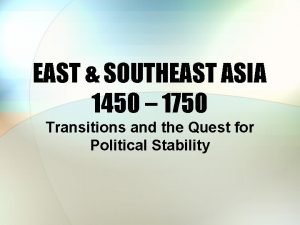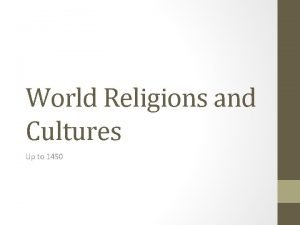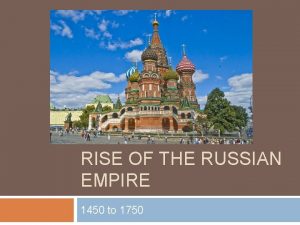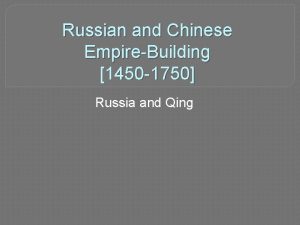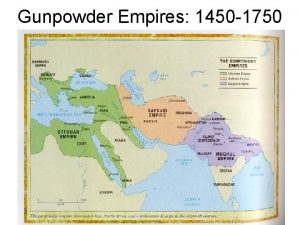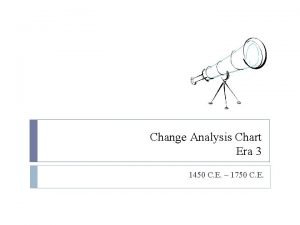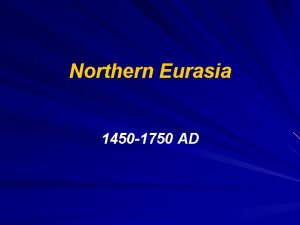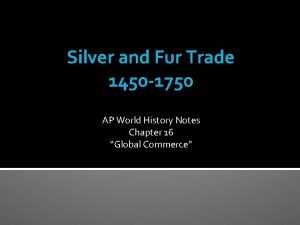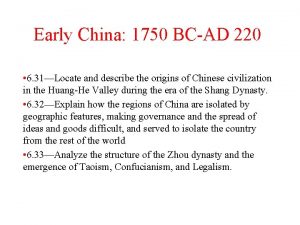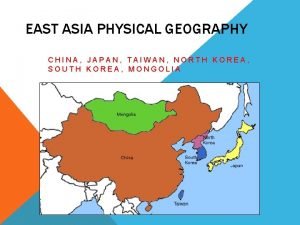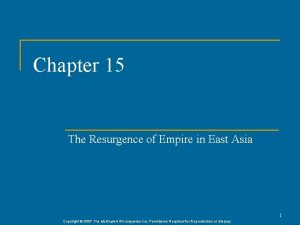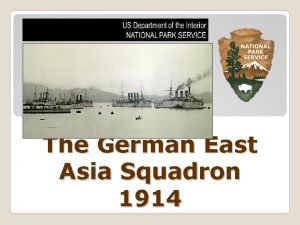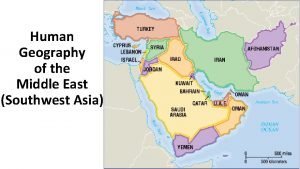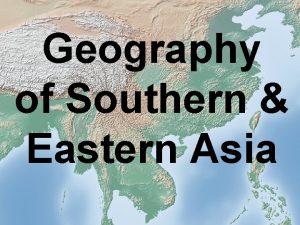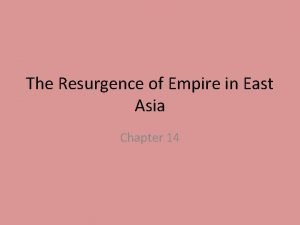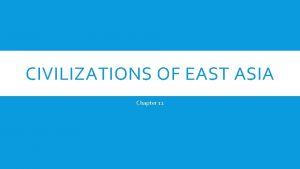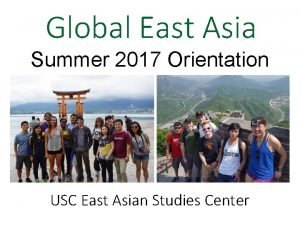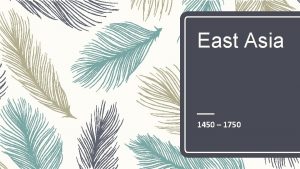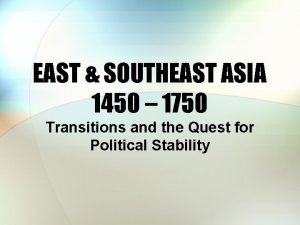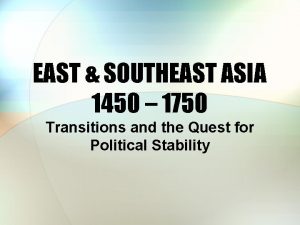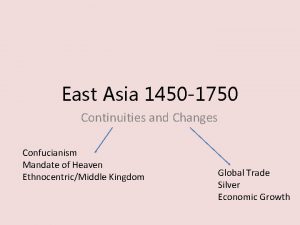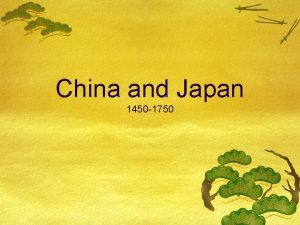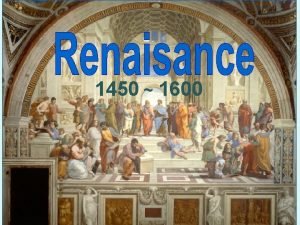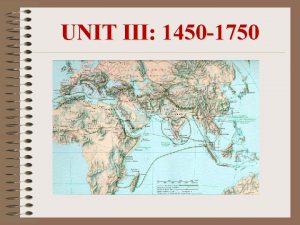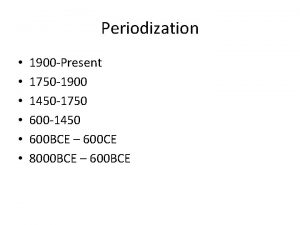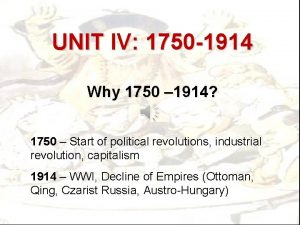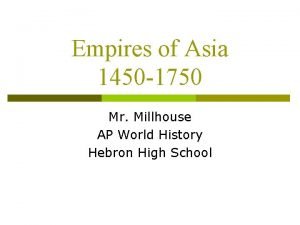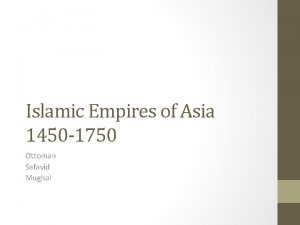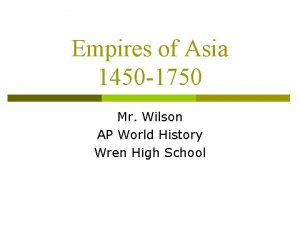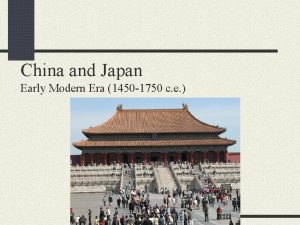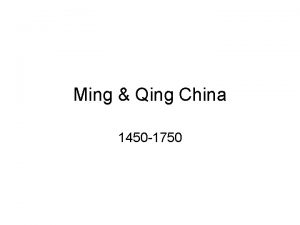East Asia 1450 1750 SPICET China under the


















- Slides: 18

East Asia 1450 – 1750 SPICE-T

China under the Ming Dynasty 1368 -1644 – Social – Political – Overthrew the (Mongol) Yuan Dynasty – Conservative – they want to return to traditions of China’s past prior to the Mongols – Interactions – Rebuilt Chinese agriculture after the Mongols

– Cultural – The Ming embrace Neo-Confucianism – Humanism and Rationalism – the universe could be understood through human reason, and that it was up to humanity to create a harmonious relationship between the universe and the individual – Economic – Largest economy in the world @ the time – Used SILVER as current – good for a while but crashed towards the end of their dynasty – Spain and Japan limited silver exports = price of silver goes up = no one could pay their taxes = problems for the Ming

– Technology – Ming Treasure Fleet – Rebuild/expand the Great Wall of China – Built the Forbidden City & Temple of Heaven in Beijing (keep it the capital)





The Voyages of Zheng He

Ming Pottery

The Portuguese in East Asia – Arrive in 1514 and build a trading empire with weapons and by constructing forts throughout the Indian Ocean – Missionaries attempt to gain influence in the Chinese royal court – Chinese are impressed with their knowledge, but still view them as barbaric – Downfall – Not enough ships and manpower to maintain an empire – 17 th c. Dutch and English arrive as rivals

Qing Dynasty

China under the Qing Dynasty 1644 – 1911 – Social – Manchu are ethnically & culturally different – Not HAN Chinese – Worked to make their culture dominant – Continue to adhere to Confucianism – Political – 1644 Peasant Revolt because of a famine = fall of the Ming – The Manchu declared a new dynasty – Maintained the Civil Service Exam and System – Emperor Kangxi – longest reign in Chinese history (1661 – 1722)– presided over a period of stability and expansion

– Interactions – Culture – Kangxi incorporates Taiwan, Mongolia, and Central Asia into the empire – Kangxi had mixed policies towards Christians – Jesuits (Catholic missionaries) were well respected because they learned Chinese – Economic – Increased exports of tea, silk, and porcelain (bought with silver!) – Technology – Kangxi built schools, compiled a dictionary, and sponsored a Collection of Books (Kind of like an encyclopedia)

China under the Qing Dynasty 1644 – 1911 (into Period 6) – Social – Manchu are ethnically & culturally different – Worked to make their culture dominant – Continue to adhere to Confucianism – Technology – Kangxi built schools, compiled a dictionary, and sponsored a Collection of Books (Kind of like an encyclopedia) – Culture – Kangxi incorporates Taiwan, Mongolia, and Central Asia into the empire

JAPAN 1450 - 1750

Japan and the Tokugawa Shogunate – Social – Samurai warrior class declines in importance (they’re now unemployed!) – Hierarchy: warrior class peasants and farmers artisans and merchants eta (similar to the untouchables) – Political – Ruled by shoguns (military leaders) – 12 th c to 15 th c – Shoguns in conflict with the daimyo (powerful landholding aristocrats) in 1500 s – Tokugawa Shogunate reduces the power of the daimyo and rules until the mid nineteenth century – Interactions – It’s an island@

– Culture – Haiku poetry develops – Economic – Silk production flourishes – Banking and paper money spurs commercial development – Agricultural production increases resulting in a surplus
 Southeast asia 1450 to 1750
Southeast asia 1450 to 1750 Spice chart tang and song
Spice chart tang and song Religion in 1450 to 1750
Religion in 1450 to 1750 Russian empire 1750
Russian empire 1750 Russian empire 1450-1750
Russian empire 1450-1750 Land based empires 1450 to 1750
Land based empires 1450 to 1750 Change analysis chart 1450 to 1750
Change analysis chart 1450 to 1750 Mughal empire 1450 to 1750
Mughal empire 1450 to 1750 Japan 1450-1750
Japan 1450-1750 Fur trade ap world history
Fur trade ap world history 1750 bc ancient china
1750 bc ancient china Physical geography of east asia
Physical geography of east asia Chapter 15 the resurgence of empire in east asia
Chapter 15 the resurgence of empire in east asia German east asia squadron
German east asia squadron Is middle east in asia
Is middle east in asia Southern and eastern asia physical features map
Southern and eastern asia physical features map Chapter 14 the resurgence of empire in east asia
Chapter 14 the resurgence of empire in east asia Lesson quiz 11-1 civilizations of east asia
Lesson quiz 11-1 civilizations of east asia Easc usc
Easc usc
